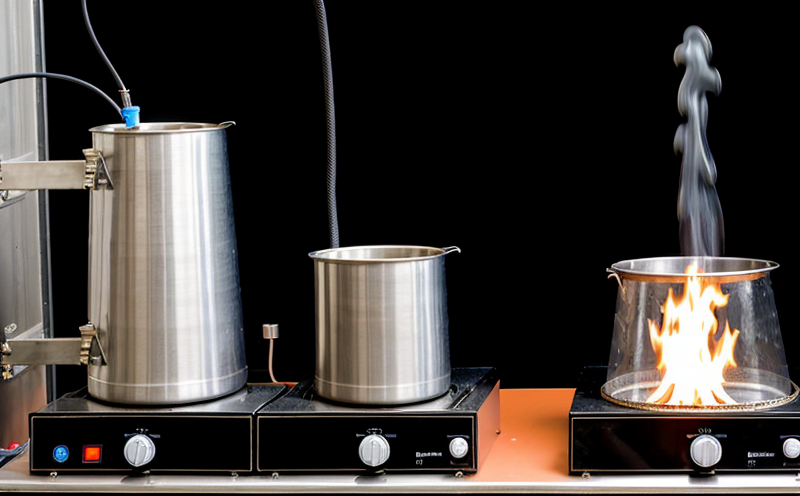Fire Performance Testing of Plastics with Calorimetry
In today's rapidly evolving material science landscape, ensuring that plastics meet stringent fire safety standards is paramount. Fire performance testing, particularly when coupled with calorimetric analysis, provides critical insights into the behavior of plastic materials under heat and flame conditions. This service is essential for manufacturers aiming to comply with international regulations while also enhancing product safety.
The process involves subjecting plastic samples to controlled combustion in a calorimeter, which quantifies the amount of energy released during burning. This data helps determine the material's flammability, smoke production, and heat release rate (HRR), all critical factors for fire safety compliance. The testing not only aids in meeting regulatory requirements such as ISO 56602 but also supports continuous improvement in product design.
Calorimetry plays a pivotal role in understanding the thermal stability of plastics, which is vital given the increasing use of these materials across various industries, including automotive, electronics, and construction. The test apparatus used includes specialized calorimeters designed to simulate real-world fire scenarios accurately. This allows for precise measurement of heat release rates, smoke production indices (SPI), and oxygen index (OI).
One key aspect of this service is the thorough preparation of the plastic specimens. Samples must be cut to specific dimensions, ensuring consistency across tests. The choice of specimen size can significantly impact the results, as larger samples may burn differently than smaller ones due to variations in heat distribution and flame propagation.
The calorimeter itself operates on advanced principles, measuring the energy released during combustion by monitoring temperature changes within a controlled environment. This data is then analyzed using sophisticated software that calculates key parameters such as maximum heat release rate (MHR), time-to-ignition, and peak heat release rate. These metrics provide a comprehensive picture of how the plastic behaves in a fire situation.
Compliance with standards like ISO 56602 ensures that the results are universally accepted by regulatory bodies worldwide. Additionally, this service supports R&D efforts by providing detailed insights into material behavior under extreme conditions, allowing for iterative improvements and innovation. For quality managers and compliance officers, this testing is crucial in maintaining a robust quality control process.
In the realm of procurement, understanding the fire performance characteristics of plastics can help in selecting suppliers who meet the highest safety standards. This service not only ensures product integrity but also contributes to broader corporate sustainability goals by reducing risks associated with flammable materials.
Benefits
Implementing fire performance testing of plastics through calorimetry offers a myriad of benefits, enhancing both safety and compliance:
- Regulatory Compliance: Ensures that products meet international standards such as ISO 56602.
- Safety Assurance: Provides critical data on flammability, smoke production, and heat release rates.
- Innovation Support: Allows for the refinement of product design based on real-world testing conditions.
- Risk Mitigation: Identifies potential hazards early in the development process, reducing liability risks.
- Enhanced Brand Reputation: Demonstrates a commitment to quality and safety, enhancing consumer trust.
- Cost Efficiency: Early detection of issues can save costs associated with product recalls and redesigns.
Quality and Reliability Assurance
The quality and reliability of the testing service are paramount, ensuring accurate and consistent results. Our laboratory employs experienced technicians who adhere strictly to international standards such as ISO 56602 for calorimetric analysis. The use of state-of-the-art equipment guarantees precision and repeatability in every test conducted.
Our commitment to quality extends beyond the testing process itself. We offer comprehensive reporting services that provide detailed insights into each test, including graphical representations of heat release rates and other key metrics. This transparency allows clients to make informed decisions about their product development processes.
We also maintain strict calibration procedures for all instruments used in calorimetric analysis, ensuring that every measurement is accurate and reliable. Our quality assurance team conducts regular audits to ensure compliance with international standards and best practices.
Competitive Advantage and Market Impact
In a highly competitive market, fire safety testing of plastics through calorimetry can provide significant advantages. By ensuring that your products meet or exceed the highest safety standards, you position yourself as a leader in quality and innovation.
Compliance with international standards such as ISO 56602 not only enhances product safety but also opens up new markets. Many regions have specific regulations regarding flammability and smoke production, and meeting these requirements can expand your customer base significantly.
The data obtained from calorimetric testing can be leveraged to improve product performance continuously. This ongoing improvement cycle ensures that you remain at the forefront of technological advancements in fire safety materials. Moreover, it allows for the development of safer products that meet both current and future regulatory requirements.
By demonstrating a commitment to quality through rigorous testing, you can build strong relationships with customers who value safety and reliability. This trust fosters long-term partnerships, which are crucial for sustained market success.





